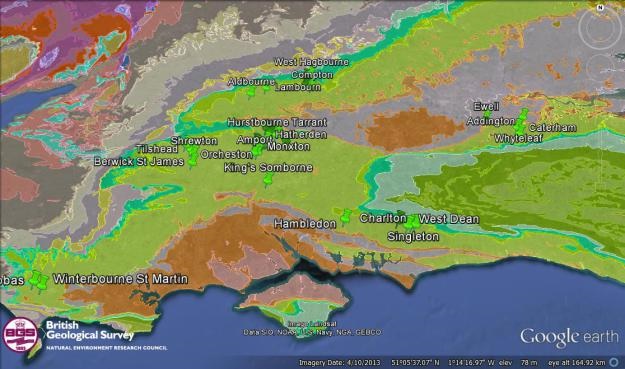Communities affected by groundwater flooding
Communities in Dorset, Hampshire, Berkshire, Oxfordshire, Kent, Wiltshire, Surrey and West Sussex are prone to suffering from groundwater flooding. It has been estimated by the British Geological Survey that 122,000 to 290,000 properties in England lie in areas at risk of groundwater flooding. While groundwater flooding is a complex phenomenon, when it does occur, it persists for weeks or even months and can cause greater damage to properties than river flooding. Areas where basements are common are often worst impacted, particularly where there has been a trend to convert basements into living areas.
Exceptional winter rainfall can caused the water table to rise above the ground surface, so that groundwater emerges in springs, stream beds and sewers across the South of England. Historically all of the villages which have experienced groundwater flooding are on, or just downstream of, the Chalk aquifer (Chalk outcrop is pale green in the image below). Why the Chalk in particular?

Chalk is a white, fine-grained limestone than crops out in a swathe across south and east England. It is the UK’s principal aquifer and it provides the most groundwater for drinking water supplies. Chalk has many unique hydrogeological characteristics that make it particularly prone to groundwater flooding. Presented in a paper written by Richard Bradford and Karen Croker in 2007. In summary:
- Chalky soils are thin and fractures in the chalk rock, when saturated by intense rainfall can let water straight through the upper parts of the aquifer to immediately recharge the water table.

- Hydraulic conductivity (the property that describes how easily groundwater moves through an aquifer) in the chalk is highest nearer the ground surface, at levels where the water table seldom reaches. So after a winter with heavy, persistent rainfall, when the water table is very high, water can move through the aquifer almost unimpeded.
- Chalk has a very low effective porosity, that is, the volume of rock through which water can flow is very small. So when rainfall reaches the aquifer, the water table rises very quickly because the porosity is filled very quickly. This leads to very steep hydraulic gradients (i.e. the slope of the water table) towards river valleys, so the unimpeded water at the top of the aquifer just drains straight out of the aquifer.
- Catchment areas for chalk streams are enormous. Streams do not arise high in the Chalk Downs, like on other hilly areas, because all the rainwater infiltrates to become groundwater. So when water tables are high, all the rainfall reaching these huge catchments flows straight out of the aquifer into what is normally quite a small stream.
Steeper hydraulic gradients often lead to streams emerging higher up the valley than usual. Since these locations do not normally see flows they seldom have a well-developed natural drainage channel. Any channel that may be present may not be well maintained because flows are rare. Emergent groundwater cannot easily flow out of the area, and it can’t sink into the ground, so these groundwater floods tend to persist for weeks and sometimes months.
For groundwater flooding, there’s no other UK aquifer like the Chalk. Groundwater from other limestone aquifers sometimes cause flooding but not in the dramatic way that chalk groundwater does. Sandstones have lower hydraulic conductivities and higher porosities so they cannot sustain the high flows necessary to cause flooding (and the drainage network on sandstone is denser so there is always a stream or a brook for the groundwater to discharge to).
At Unda we offer a reality-checking service to help you understand whether your property is genuinely at risk of groundwater flooding. For more information contact us.
Dr. Buss is Assistant Scientific Editor at the Quarterly Journal of Engineering Geology and Hydrogeology.